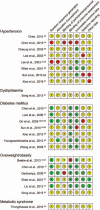Efficacy of Tai Chi and qigong for the prevention of stroke and stroke risk factors: A systematic review with meta-analysis
- PMID: 29137055
- PMCID: PMC5690748
- DOI: 10.1097/MD.0000000000008517
Efficacy of Tai Chi and qigong for the prevention of stroke and stroke risk factors: A systematic review with meta-analysis
Abstract
Background: This review aims to summarize the evidence of Tai Chi and qigong interventions for the primary prevention of stroke, including the effects on populations with major stroke risk factors.
Methods: A systematic literature search was conducted on January 16, 2017 using the PubMed, Scopus, Cochrane Library, and CINAHL databases. Randomized controlled trials examining the efficacy of Tai Chi or qigong for stroke prevention and stroke risk factors were included. Risk of bias was assessed using the Cochrane Risk of Bias tool.
Results: Twenty-one trials with n = 1604 patients with hypertension, hyperlipidaemia, diabetes, overweight or obesity, or metabolic syndrome were included. No trials were found that examined the effects of Tai Chi/qigong on stroke incidence. Meta-analyses revealed significant, but not robust, benefits of Tai Chi/qigong over no interventions for hypertension (systolic blood pressure: -15.55 mm Hg (95% CI: -21.16; -9.95); diastolic blood pressure: -10.66 mm Hg (95% CI: -14.90, -6.43); the homeostatic model assessment (HOMA) index (-2.86%; 95% CI: -5.35, -0.38) and fasting blood glucose (-9.6 mg/dL; 95% CI: -17.28, -1.91), and for the body mass index compared with exercise controls (-1.65 kg/m; 95% CI: -3.11, -0.20). Risk of bias was unclear or high for the majority of trials and domains, and heterogeneity between trials was high. Only 6 trials adequately reported safety. No recommendation for the use of Tai Chi/qigong for the prevention of stroke can be given.
Conclusion: Although Tai Chi and qigong show some potential more robust studies are required to provide conclusive evidence on the efficacy and safety of Tai Chi and qigong for reducing major stroke risk factors.
Conflict of interest statement
The authors have no conflicts of interest to disclose.
Figures



Similar articles
-
A systematic review and meta-analysis of the effects of Qigong and Tai Chi for depressive symptoms.Complement Ther Med. 2015 Aug;23(4):516-34. doi: 10.1016/j.ctim.2015.05.001. Epub 2015 May 27. Complement Ther Med. 2015. PMID: 26275645
-
The effect of Tai Chi in elderly individuals with sarcopenia and frailty: A systematic review and meta-analysis of randomized controlled trials.Ageing Res Rev. 2022 Dec;82:101747. doi: 10.1016/j.arr.2022.101747. Epub 2022 Oct 9. Ageing Res Rev. 2022. PMID: 36223875
-
Tai Chi for anxiety and depression symptoms in cancer, stroke, heart failure, and chronic obstructive pulmonary disease: A systematic review and meta-analysis.Complement Ther Clin Pract. 2022 Feb;46:101510. doi: 10.1016/j.ctcp.2021.101510. Epub 2021 Nov 2. Complement Ther Clin Pract. 2022. PMID: 34749040
-
Drugs for preventing postoperative nausea and vomiting in adults after general anaesthesia: a network meta-analysis.Cochrane Database Syst Rev. 2020 Oct 19;10(10):CD012859. doi: 10.1002/14651858.CD012859.pub2. Cochrane Database Syst Rev. 2020. PMID: 33075160 Free PMC article.
-
Metformin for women who are overweight or obese during pregnancy for improving maternal and infant outcomes.Cochrane Database Syst Rev. 2018 Jul 24;7(7):CD010564. doi: 10.1002/14651858.CD010564.pub2. Cochrane Database Syst Rev. 2018. PMID: 30039871 Free PMC article.
Cited by
-
Tai Chi for the treatment of chronic obstructive pulmonary disease: A systematic review protocol.Medicine (Baltimore). 2019 Jun;98(26):e16097. doi: 10.1097/MD.0000000000016097. Medicine (Baltimore). 2019. PMID: 31261524 Free PMC article.
-
Tai Chi exercise improves age-associated decline in cerebrovascular function: a cross-sectional study.BMC Geriatr. 2021 May 6;21(1):293. doi: 10.1186/s12877-021-02196-9. BMC Geriatr. 2021. PMID: 33957879 Free PMC article. Clinical Trial.
-
Strategies to Improve Long-Term Outcomes for Patients with Chronic Kidney Disease in China.Kidney Dis (Basel). 2023 Apr 11;9(4):265-276. doi: 10.1159/000530022. eCollection 2023 Aug. Kidney Dis (Basel). 2023. PMID: 37899997 Free PMC article. Review.
-
Mind-Body Therapies From Traditional Chinese Medicine: Evidence Map.Front Public Health. 2021 Dec 10;9:659075. doi: 10.3389/fpubh.2021.659075. eCollection 2021. Front Public Health. 2021. PMID: 34988045 Free PMC article.
-
Effectiveness of Tai Chi for Health Promotion of Older Adults: A Scoping Review of Meta-Analyses.Am J Lifestyle Med. 2021 Mar 24;16(6):700-716. doi: 10.1177/15598276211001291. eCollection 2022 Nov-Dec. Am J Lifestyle Med. 2021. PMID: 36389043 Free PMC article.
References
-
- Mozaffarian D, Benjamin EJ, Go AS, et al. Heart Disease and Stroke Statistics-2016 Update: a report from the American Heart Association. Circulation 2016;133:e38–60. - PubMed
-
- World Health Organization (WHO). Global Health Estimates: Deaths by Cause, Age, Sex and Country, 2000–2012. Geneva: WHO; 2014.
-
- George MG, Tong X, Kuklina EV, et al. Trends in stroke hospitalizations and associated risk factors among children and young adults, 1995-2008. Ann Neurol 2011;70:713–21. - PubMed
-
- Feigin VL, Roth GA, Naghavi M, et al. Global burden of stroke and risk factors in 188 countries, during 1990-2013: a systematic analysis for the Global Burden of Disease Study 2013. Lancet Neurol 2016;15:913–24. - PubMed
Publication types
MeSH terms
Substances
LinkOut - more resources
Full Text Sources
Other Literature Sources
Medical

